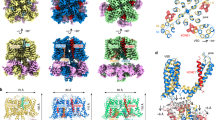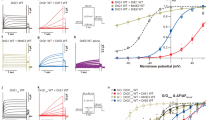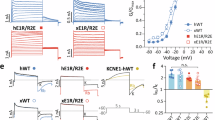Abstract
KCNQ1 potassium channels are essential for physiological processes such as cardiac rhythm and intestinal chloride secretion. KCNE family subunits (KCNE1–5) associate with KCNQ1, conferring distinct properties across various tissues. KCNQ1 activation requires membrane depolarization and phosphatidylinositol 4,5-bisphosphate (PIP2) whose cellular levels are controlled by Gαq-coupled GPCR activation. While modulation of KCNQ1’s voltage-dependent activation by KCNE1/3 is well-characterized, their effects on PIP2-dependent gating of KCNQ1 via GPCR signaling remain less understood. Here we resolved structures of KCNQ1–KCNE1 and reassessed the reported KCNQ1–KCNE3 structures with and without PIP2. We revealed that KCNQ1–KCNE1/3 complexes feature two PIP2-binding sites, with KCNE1/3 contributing to a previously overlooked, uncharacterized site involving residues critical for coupling voltage sensor and pore domains. Via this site, KCNE1 and KCNE3 distinctly modulate the PIP2-dependent gating, in addition to the voltage sensitivity, of KCNQ1. Consequently, KCNE3 converts KCNQ1 into a voltage-insensitive PIP2-gated channel governed by GPCR signaling to maintain ion homeostasis in non-excitable cells. KCNE1, by significantly enhancing KCNQ1’s PIP2 affinity and resistance to GPCR regulation, forms predominantly voltage-gated channels with KCNQ1 for conducting the slow-delayed rectifier current in excitable cardiac cells. Our study highlights how KCNE1/3 modulates KCNQ1 gating in different cellular contexts, providing insights into tissue-specifically targeting multi-functional channels.
This is a preview of subscription content, access via your institution
Access options
Subscribe to this journal
Receive 12 digital issues and online access to articles
$119.00 per year
only $9.92 per issue
Buy this article
- Purchase on SpringerLink
- Instant access to full article PDF
Prices may be subject to local taxes which are calculated during checkout





Similar content being viewed by others
Data availability
Plasmids generated in this study are available upon request. All tpr files associated with MD simulations in this study are available through the link at Zenodo (https://zenodo.org/records/14632060). The cryo-EM maps of KCNQ1( + PIP2) and KCNQ1–KCNE1 ( + /–PIP2) have been deposited in the Electron Microscopy Data Bank under the accession codes: EMD-65013 (KCNQ1 with PIP2, bent), EMD-65014 (KCNQ1 with PIP2, straight), EMD-64997 (KCNQ1–KCNE1, bent) and EMD-65008 (KCNQ1–KCNE1 with PIP2, straight). The corresponding coordinates have been deposited in the Protein Data Bank under the accession codes: 9VEN, 9VEO, 9VEC, and 9VEI.
References
Abbott, G. W. et al. KCNQ1, KCNE2, and Na+-coupled solute transporters form reciprocally regulating complexes that affect neuronal excitability. Sci. Signal 7, ra22 (2014).
Preston, P. et al. Disruption of the K+ channel beta-subunit KCNE3 reveals an important role in intestinal and tracheal Cl- transport. J. Biol. Chem. 285, 7165–7175 (2010).
Manderfield, L. J. & George, A. L. Jr KCNE4 can co-associate with the I(Ks) (KCNQ1-KCNE1) channel complex. FEBS J. 275, 1336–1349 (2008).
Kunzelmann, K. et al. Expression and function of colonic epithelial KvLQT1 K+ channels. Clin. Exp. Pharm. Physiol. 28, 79–83 (2001).
Grahammer, F. et al. The cardiac K+ channel KCNQ1 is essential for gastric acid secretion. Gastroenterology 120, 1363–1371 (2001).
Schroeder, B. C. et al. A constitutively open potassium channel formed by KCNQ1 and KCNE3. Nature 403, 196–199 (2000).
Barhanin, J. et al. K(V)LQT1 and lsK (minK) proteins associate to form the I(Ks) cardiac potassium current. Nature 384, 78–80 (1996).
Sanguinetti, M. C. et al. Coassembly of K(V)LQT1 and minK (IsK) proteins to form cardiac I(Ks) potassium channel. Nature 384, 80–83 (1996).
Jespersen, T., Grunnet, M. & Olesen, S. P. The KCNQ1 potassium channel: from gene to physiological function. Physiology 20, 408–416 (2005).
Yu, X. X. et al. Associations of KCNQ1 polymorphisms with the risk of type 2 diabetes mellitus: an updated meta-analysis with trial sequential analysis. J. Diabetes Res. 2020, 7145139 (2020).
Lubberding, A. F. et al. Celebrities in the heart, strangers in the pancreatic beta cell: voltage-gated potassium channels K(v) 7.1 and K(v) 11.1 bridge long QT syndrome with hyperinsulinaemia as well as type 2 diabetes. Acta Physiol. 234, e13781 (2022).
Nakano, Y. & Shimizu, W. Genetics of long-QT syndrome. J. Hum. Genet. 61, 51–55 (2016).
McCrossan, Z. A. & Abbott, G. W. The MinK-related peptides. Neuropharmacology 47, 787–821 (2004).
Roura-Ferrer, M. et al. Impact of KCNE subunits on KCNQ1 (Kv7.1) channel membrane surface targeting. J. Cell Physiol. 225, 692–700 (2010).
Van Horn, W. D., Vanoye, C. G. & Sanders, C. R. Working model for the structural basis for KCNE1 modulation of the KCNQ1 potassium channel. Curr. Opin. Struct. Biol. 21, 283–291 (2011).
Sesti, F. & Goldstein, S. A. Single-channel characteristics of wild-type IKs channels and channels formed with two minK mutants that cause long QT syndrome. J. Gen. Physiol. 112, 651–663 (1998).
Yang, Y. & Sigworth, F. J. Single-channel properties of IKs potassium channels. J. Gen. Physiol. 112, 665–678 (1998).
Barro-Soria, R., Perez, M. E. & Larsson, H. P. KCNE3 acts by promoting voltage sensor activation in KCNQ1. Proc. Natl. Acad. Sci. USA 112, E7286–E7292 (2015).
Barro-Soria, R. et al. KCNE1 and KCNE3 modulate KCNQ1 channels by affecting different gating transitions. Proc. Natl. Acad. Sci. USA 114, E7367–E7376 (2017).
Abbott, G. W. KCNE1 and KCNE3: The yin and yang of voltage-gated K(+) channel regulation. Gene. 576, 1–13 (2016).
Al-Hazza, A., Linley, J., Aziz, Q., Hunter, M. & Sandle, G. Upregulation of basolateral small conductance potassium channels (KCNQ1/KCNE3) in ulcerative colitis. Biochem Biophys. Res Commun. 470, 473–478 (2016).
Angelo, K. et al. KCNE5 induces time- and voltage-dependent modulation of the KCNQ1 current. Biophys. J. 83, 1997–2006 (2002).
Grunnet, M. et al. KCNE4 is an inhibitory subunit to the KCNQ1 channel. J. Physiol. 542, 119–130 (2002).
Tinel, N., Diochot, S., Borsotto, M., Lazdunski, M. & Barhanin, J. KCNE2 confers background current characteristics to the cardiac KCNQ1 potassium channel. EMBO J. 19, 6326–6330 (2000).
Loussouarn, G. et al. Phosphatidylinositol-4,5-bisphosphate, PIP2, controls KCNQ1/KCNE1 voltage-gated potassium channels: a functional homology between voltage-gated and inward rectifier K+ channels. EMBO J. 22, 5412–5421 (2003).
Zaydman, M. A. et al. Kv7.1 ion channels require a lipid to couple voltage sensing to pore opening. Proc. Natl. Acad. Sci. USA 110, 13180–13185 (2013).
Zaydman, M. A. & Cui, J. PIP2 regulation of KCNQ channels: biophysical and molecular mechanisms for lipid modulation of voltage-dependent gating. Front Physiol. 5, 195 (2014).
Sun, J. & MacKinnon, R. Cryo-EM structure of a KCNQ1/CaM complex reveals insights into congenital long QT syndrome. Cell 169, 1042–1050.e9 (2017).
Sun, J. & MacKinnon, R. Structural basis of human KCNQ1 modulation and gating. Cell 180, 340–347.e9 (2020).
Ma, D. et al. Structural mechanisms for the activation of human cardiac KCNQ1 channel by electro-mechanical coupling enhancers. Proc. Natl. Acad. Sci. USA 119, e2207067119 (2022).
Sanchez-Fernandez, G. et al. Galphaq signalling: the new and the old. Cell Signal 26, 833–848 (2014).
Brown, D. A. & Adams, P. R. Muscarinic suppression of a novel voltage-sensitive K+ current in a vertebrate neurone. Nature 283, 673–676 (1980).
Li, Y. et al. KCNE1 enhances phosphatidylinositol 4,5-bisphosphate (PIP2) sensitivity of IKs to modulate channel activity. Proc. Natl. Acad. Sci. USA 108, 9095–9100 (2011).
Chung, D. Y. et al. Location of KCNE1 relative to KCNQ1 in the I(KS) potassium channel by disulfide cross-linking of substituted cysteines. Proc. Natl. Acad. Sci. USA 106, 743–748 (2009).
Nath, A., Atkins, W. M. & Sligar, S. G. Applications of phospholipid bilayer nanodiscs in the study of membranes and membrane proteins. Biochemistry 46, 2059–2069 (2007).
Denisov, I. G. & Sligar, S. G. Nanodiscs for structural and functional studies of membrane proteins. Nat. Struct. Mol. Biol. 23, 481–486 (2016).
Willegems, K. et al. Structural and electrophysiological basis for the modulation of KCNQ1 channel currents by ML277. Nat. Commun. 13, 3760 (2022).
Wang, K. W. & Goldstein, S. A. Subunit composition of minK potassium channels. Neuron 14, 1303–1309 (1995).
Wang, W., Xia, J. & Kass, R. S. MinK-KvLQT1 fusion proteins, evidence for multiple stoichiometries of the assembled IsK channel. J. Biol. Chem. 273, 34069–34074 (1998).
Chen, H., Kim, L. A., Rajan, S., Xu, S. & Goldstein, S. A. Charybdotoxin binding in the I(Ks) pore demonstrates two MinK subunits in each channel complex. Neuron 40, 15–23 (2003).
Morin, T. J. & Kobertz, W. R. Counting membrane-embedded KCNE beta-subunits in functioning K+ channel complexes. Proc. Natl. Acad. Sci. USA 105, 1478–1482 (2008).
Nakajo, K., Ulbrich, M. H., Kubo, Y. & Isacoff, E. Y. Stoichiometry of the KCNQ1 - KCNE1 ion channel complex. Proc. Natl. Acad. Sci. USA 107, 18862–18867 (2010).
Murray, C. I. et al. Unnatural amino acid photo-crosslinking of the IKs channel complex demonstrates a KCNE1:KCNQ1 stoichiometry of up to 4:4. Elife 5, e11815 (2016).
Long, S. B., Campbell, E. B. & Mackinnon, R. Crystal structure of a mammalian voltage-dependent Shaker family K+ channel. Science 309, 897–903 (2005).
Zheng, Y. et al. Structural insights into the lipid and ligand regulation of a human neuronal KCNQ channel. Neuron 110, 237–247.e4 (2022).
Ishii, M. & Kurachi, Y. Muscarinic acetylcholine receptors. Curr. Pharm. Des. 12, 3573–3581 (2006).
Tang, C., Castoldi, A. F. & Costa, L. G. Effects of the muscarinic agonist oxotremorine on membrane fluidity in rat lymphocytes. Biochem Mol. Biol. Int. 29, 1047–1054 (1993).
Sabbir, M. G., Calcutt, N. A. & Fernyhough, P. Muscarinic acetylcholine type 1 receptor activity constrains neurite outgrowth by inhibiting microtubule polymerization and mitochondrial trafficking in adult sensory neurons. Front Neurosci. 12, 402 (2018).
Bae, Y. S. et al. Identification of a compound that directly stimulates phospholipase C activity. Mol. Pharm. 63, 1043–1050 (2003).
Mandala, V. S. & MacKinnon, R. The membrane electric field regulates the PIP(2)-binding site to gate the KCNQ1 channel. Proc. Natl. Acad. Sci. USA 120, e2301985120 (2023).
Matavel, A. & Lopes, C. M. PKC activation and PIP(2) depletion underlie biphasic regulation of IKs by Gq-coupled receptors. J. Mol. Cell Cardiol. 46, 704–712 (2009).
Jensen, B. C., O’Connell, T. D. & Simpson, P. C. Alpha-1-adrenergic receptors: targets for agonist drugs to treat heart failure. J. Mol. Cell Cardiol. 51, 518–528 (2011).
Kienitz, M. C., Vladimirova, D., Muller, C., Pott, L. & Rinne, A. Receptor species-dependent desensitization controls KCNQ1/KCNE1 K+ channels as downstream effectors of Gq protein-coupled receptors. J. Biol. Chem. 291, 26410–26426 (2016).
Daleau, P. & Turgeon, J. Angiotensin II modulates the delayed rectifier potassium current of guinea pig ventricular myocytes. Pflug. Arch. 427, 553–555 (1994).
Matsumoto, Y. et al. Histamine H1-receptor-mediated modulation of the delayed rectifier K+ current in guinea-pig atrial cells: opposite effects on IKs and IKr. Br. J. Pharm. 128, 1545–1553 (1999).
Julio-Kalajzic, F. et al. K(2P) TASK-2 and KCNQ1-KCNE3 K(+) channels are major players contributing to intestinal anion and fluid secretion. J. Physiol. 596, 393–407 (2018).
Abbott, G. W. et al. MiRP1 forms IKr potassium channels with HERG and is associated with cardiac arrhythmia. Cell 97, 175–187 (1999).
Bian, J., Cui, J. & McDonald, T. V. HERG K(+) channel activity is regulated by changes in phosphatidyl inositol 4,5-bisphosphate. Circ. Res. 89, 1168–1176 (2001).
Lussier, Y. et al. Disease-linked mutations alter the stoichiometries of HCN-KCNE2 complexes. Sci. Rep. 9, 9113 (2019).
McCrossan, Z. A. et al. MinK-related peptide 2 modulates Kv2.1 and Kv3.1 potassium channels in mammalian brain. J. Neurosci. 23, 8077–8091 (2003).
Abbott, G. W. Beta subunits control the effects of human Kv4.3 potassium channel phosphorylation. Front Physiol. 8, 646 (2017).
Avalos Prado, P. et al. KCNE1 is an auxiliary subunit of two distinct ion channel superfamilies. Cell 184, 534–544.e11 (2021).
Talbi, K., Ousingsawat, J., Centeio, R., Schreiber, R. & Kunzelmann, K. KCNE1 does not shift TMEM16A from a Ca(2+) dependent to a voltage dependent Cl(-) channel and is not expressed in renal proximal tubule. Pflug. Arch. 475, 995–1007 (2023).
Gada, K. D. & Logothetis, D. E. PKC regulation of ion channels: the involvement of PIP(2). J. Biol. Chem. 298, 102035 (2022).
Zheng, S. Q. et al. MotionCor2: anisotropic correction of beam-induced motion for improved cryo-electron microscopy. Nat. Methods 14, 331–332 (2017).
Rohou, A. & Grigorieff, N. CTFFIND4: fast and accurate defocus estimation from electron micrographs. J. Struct. Biol. 192, 216–221 (2015).
Punjani, A., Rubinstein, J. L., Fleet, D. J. & Brubaker, M. A. cryoSPARC: algorithms for rapid unsupervised cryo-EM structure determination. Nat. Methods 14, 290–296 (2017).
Kimanius, D., Dong, L., Sharov, G., Nakane, T. & Scheres, S. H. W. New tools for automated cryo-EM single-particle analysis in RELION-4.0. Biochem J. 478, 4169–4185 (2021).
Goddard, T. D. et al. UCSF ChimeraX: meeting modern challenges in visualization and analysis. Protein Sci. 27, 14–25 (2018).
Asarnow, D., Palovcak, E., Cheng, Y. UCSF pyem v0.5, <https://doi.org/10.5281/zenodo.3576630 > (2019).
Emsley, P. & Cowtan, K. Coot: model-building tools for molecular graphics. Acta Crystallogr D Biol. Crystallogr. 60, 2126–2132 (2004).
Moriarty, N. W., Grosse-Kunstleve, R. W. & Adams, P. D. electronic Ligand Builder and Optimization Workbench (eLBOW): a tool for ligand coordinate and restraint generation. Acta Crystallogr. D Biol. Crystallogr. 65, 1074–1080 (2009).
Afonine, P. V. et al. Real-space refinement in PHENIX for cryo-EM and crystallography. Acta Crystallogr. D Struct. Biol. 74, 531–544 (2018).
Chen, V. B. et al. MolProbity: all-atom structure validation for macromolecular crystallography. Acta Crystallogr. D Biol. Crystallogr. 66, 12–21 (2010).
Smart, O. S., Neduvelil, J. G., Wang, X., Wallace, B. A. & Sansom, M. S. HOLE: a program for the analysis of the pore dimensions of ion channel structural models. J. Mol. Graph 14, 354–360, 376 (1996).
Pettersen, E. F. et al. UCSF Chimera-a visualization system for exploratory research and analysis. J. Comput. Chem. 25, 1605–1612 (2004).
Jurrus, E. et al. Improvements to the APBS biomolecular solvation software suite. Protein Sci. 27, 112–128 (2018).
Waterhouse, A. et al. SWISS-MODEL: homology modelling of protein structures and complexes. Nucleic Acids Res. 46, W296–W303 (2018).
Ye, W. et al. Activation and closed-state inactivation mechanisms of the human voltage-gated K(V)4 channel complexes. Mol. Cell 82, 2427–2442.e4 (2022).
Marrink, S. J., Risselada, H. J., Yefimov, S., Tieleman, D. P. & de Vries, A. H. The MARTINI force field: coarse grained model for biomolecular simulations. J. Phys. Chem. B. 111, 7812–7824 (2007).
Wassenaar, T. A., Ingolfsson, H. I., Bockmann, R. A., Tieleman, D. P. & Marrink, S. J. Computational lipidomics with insane: a versatile tool for generating custom membranes for molecular simulations. J. Chem. Theory Comput. 11, 2144–2155 (2015).
Pronk, S. et al. GROMACS 4.5: a high-throughput and highly parallel open source molecular simulation toolkit. Bioinformatics 29, 845–854 (2013).
Bussi, G., Donadio, D. & Parrinello, M. Canonical sampling through velocity rescaling. J. Chem. Phys. 126, 014101 (2007).
Parrinello, M. & Rahman, A. Polymorphic transitions in single crystals: a new molecular dynamics method. J. Appl. Phys. 52, 7182–7190 (1981).
Corey, R. A., Vickery, O. N., Sansom, M. S. P. & Stansfeld, P. J. Insights into membrane protein-lipid interactions from free energy calculations. J. Chem. Theory Comput. 15, 5727–5736 (2019).
Klimovich, P. V., Shirts, M. R. & Mobley, D. L. Guidelines for the analysis of free energy calculations. J. Comput. Aided Mol. Des. 29, 397–411 (2015).
Vickery, O. N. & Stansfeld, P. J. CG2AT2: an enhanced fragment-based approach for serial multi-scale molecular dynamics simulations. J. Chem. Theory Comput. 17, 6472–6482 (2021).
Bernetti, M. & Bussi, G. Pressure control using stochastic cell rescaling. J. Chem. Phys. 153, 114107 (2020).
Acknowledgements
We thank the staff at the cryo-EM facility at St Jude Children’s Research Hospital for help with data collection, Ines Chen for constructive feedback on manuscript writing and members from Sun lab, including Xiao Chen, Patricia Hixson and Hanwen Zhu for helpful discussions and support. This research is funded by American Lebanese Syrian Associated Charities (ALSAC), President Young Professorship (PYP) from National University of Singapore, MOE Tier 1 grant A-8002958-00-00 and NIH R00HL143037 (to J.S.); US-Israel BSF research grant 2019159, NIH R01 HL155398 and R01 HL166628 (to J.C.); the Knut and Alice Wallenberg Foundation, the Science for Life Laboratory, the Swedish eScience Research Center and Swedish Research Council grants VR 2019-02433 and 2022-04305 (to L.D.); the National Academic Infrastructure for Supercomputing in Sweden (NAISS) and the Swedish Research Council through grant agreement no. 2022-06725 (to L.D.) funded the MD simulations; Ministry of Education Tier 1 and 2 grants A-8000037-00-00, A-8002962-00-00, T2EP30222-0042, National University of Singapore PYP A-0008405-00-00, A-0008405-01-00 and National Research Foundation Fellowship grant NRFF15-2023-0005 (to Y.Z.T.).
Author information
Authors and Affiliations
Contributions
J.S. and J.C. conceived, designed and supervised the study. A.A.K. and S.C. collected cryo-EM data. C.C. and A.A.K. performed cryo-EM data processing and analyzed the structures under the supervision of J.S. C.C., A.A.K. and M.J. did model building. L.Z. and S.D. conducted the electrophysical experiments and related data analysis under the supervision of J.C. T.P. performed the MD simulations and analysis under supervision of L.D. Y.Z.T. and Jingyi S. provided intellectual and technical support during the project. J.S. prepared the manuscript draft with input from all authors.
Corresponding authors
Ethics declarations
Competing interests
The authors declare no competing interests.
Additional information
Publisher’s note Springer Nature remains neutral with regard to jurisdictional claims in published maps and institutional affiliations.
Supplementary information
Rights and permissions
Springer Nature or its licensor (e.g. a society or other partner) holds exclusive rights to this article under a publishing agreement with the author(s) or other rightsholder(s); author self-archiving of the accepted manuscript version of this article is solely governed by the terms of such publishing agreement and applicable law.
About this article
Cite this article
Cui, C., Zhao, L., Kermani, A.A. et al. Mechanisms of KCNQ1 gating modulation by KCNE1/3 for cell-specific function. Cell Res (2025). https://doi.org/10.1038/s41422-025-01152-1
Received:
Accepted:
Published:
DOI: https://doi.org/10.1038/s41422-025-01152-1



